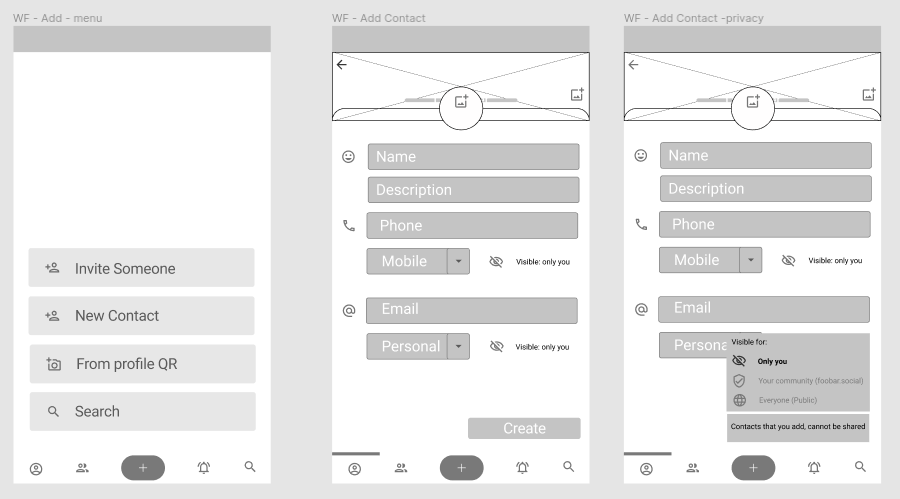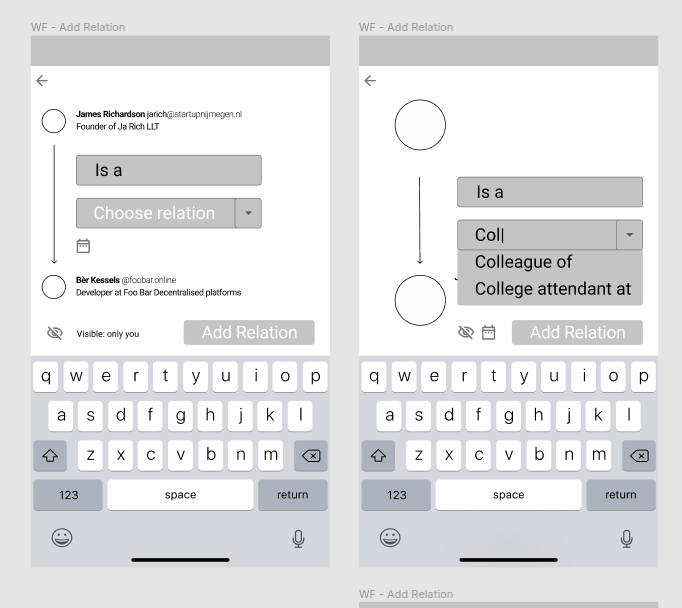A lot of people use, or used, LinkedIn as a “Rolodex on Steroids”. We want to bring that feature back as a pillar of Flockingbird.
Any profile in the entire fediverse can be added to your contacts. They then become part of your address-book.
In future, we want to provide integration with address-books on e.g. your mobile phone or on other services: that Flockingbird becomes another provider for contacts in your address-book. But first we must ensure you can actually add and enrich contacts.
Contact Details
As a flockingbird user, I can add contact details to my profile. And for each contact detail, I can configure who can see it. That way, I can add my phone number, accessible to my local community members, but not to the entire internet, for example.
Whenever I update a contact detail, this change is sent over ActivityPub to anyone who has added me as contact. To my “followers”. And when I add contact details -and the privacy settings allow the recipient to see them- we send it to my followers too.
This way, your address-book is updated automatically by the owners of the profiles!
Enriching Contact details.

Sometimes I have additional contact details for a person. Maybe that person does not want to share any contact details, maybe they have profile on the Fediverse without the ability to add contact details -such as a Mastodon account-. In all those cases, I can add additional contact details to a profile. Just like I can in any address-book. Naturally, such settings are never shared with anyone: they are enforced to stay private. Not even the person on whose profile I added these details will ever see them.
Adding non-fediverse contacts
Most of my contacts in my current address-book are not on the Fediverse. Most might never create an account there. But I still want to add an entry and the contact details. We plan to offer this feature so that flockingbird may replace your current address-book entirely.
Just as with additional contact details, such data is enforced to stay private. I cannot ever share this data with other Flockingbird users. Well, other than copy-pasting it in, say, an email, obviously. Just like with your current address-book.
One-way relations, contacting.
A difference with LinkedIn is that we don’t want “reciprocating” contacts. On LinkedIn, when someone adds you as a contact, you have to acknowledge that by adding that other person as contact too.
We believe this is a hostile feature, dressed up as feature. The hostility is that it greatly increases “contact counts”. For example, I met a person, say Bob, on a conference, and want to add that person to my contacts. But LinkedIn now forces Bob to also add me as a contact. Or at least suggests it to Bob. If Bob declines, he is not added to my contacts. I can still bookmark Bob, though. Or copy his public details to my address-book. The only thing it offers is that I cannot contact Bob now. Or, well, not without paying LinkedIn anyway.
Flockingbird will not have a chat, private message, or other feature to contact members. I can add contact details to my profile, which is how you can contact me. Contact details can be anything from an email a chat-handle, to a link to an online contact form. Why add yet another inbox to keep an eye on, when you and I have a wide range of apps, accounts and so on, on our phones, computers. I could even add contact details that explain how to send me messages by pigeon, if I prefer that way of getting contacted.
Which removes the other reason why “acknowledging” a contact request is needed: so that I can deny it and not receive your messages. If I don’t want you to contact me, I can simply not disclose my contact details to you. Of force you to train pigeons first, before sending me that inappropriate job offer.
Rich relations

In addition to just adding people as contact, I can add notes and tags to profiles. Allowing me to organize them or add some context. More on this feature in a future post, though.
Besides tagging and annotating, I can add rich one way relations. One problem with many (professional) social networks is that they lack any ranking. The contact from that business-card I picked up 12 years ago, ranks just as high as My co-founder whom I’ve spent 40+ hours a week, in an office with, for example.
A Rich relation is, for example, I ⟶am a co-founder of Flockingbird⟶ Bob. It has a direction. I am colleague of Bob does not mean Bob is colleague of Me. Or at least, it will never show up this way. Relations that I add, only ever show up on my profile and never on the other profile.
All parts from the relation are free text, so it’s entirely up to you how to use this. From I ⟶ am the tutor of⟶ Bob to I ⟶have a secret crush on⟶ Bob. Every relation has the common privacy options, so I can choose the hide the last one to anyone but me.
In addition to the free text describing the relation, I can add a date range. This way I can set that I am I ⟶ am the tutor of⟶ Bob, from June 2020 to Dec 2020.
To keep it simple, we only allow relations from you to another contact. So If I add Hogwards to my contacts, I can add I ⟶ am attending school at⟶ Hogwards.


Comments
No comments yet. Be the first to react!